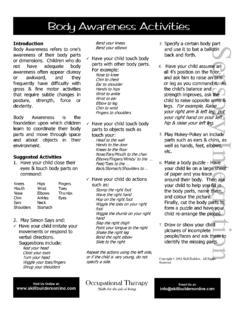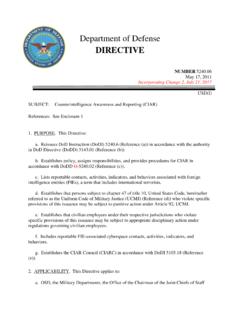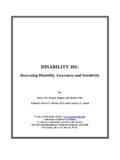Transcription of Social Emotional Activities Workbook 1 - Evanston, Illinois
1 Social Emotional Activities Workbook Section A: Self- awareness Activities Section A Self- awareness Activities Section A: Self- awareness Activities Interactive Group Reflection Activities The following is for facilitators. A Rose and a Thorn Participants are asked to state one rose, or good thing that happened for them, and one thorn, or challenge that arose. Can be used to at the beginning of a new session to reflect on the last. Can be used as a closing reflection. Standing in the Shadow of Our Success This activity is used to review and reflect on personal and group accomplishments.
2 Individually, participants are asked to consider their roles in their groups success. One by one, participants are asked to physically stand in the shadow (the place in the room) where they felt they contributed most in moving the group forward. For example, someone who helped facilitate a large group discussion might go stand by the board. Participants are invited to say 1 or 2 sentences about their contribution. Crossing the Line All participants are asked to stand on one side of the room. They are told that the facilitator will read a series of statements. Once a statement is read, all participants for whom that statement is true personally walk to the other side of the room.
3 The facilitator might use a reflective prompt such as Notice who is on one side of the room and notice who is not. Participants silently acknowledge the configuration of the room s participants. Participants are asked to rejoin the individuals who did not move. The exercise is often used to bring the group to awareness of minority viewpoints and/or power dynamics that either exist in the room or generally influence training. Index Cards Participants are given two different colored index cards. On one card they are asked to write one thing they ve learned. On the other card they are asked to write one question they (still) have.
4 This can be used as a review of the previous session or as a closing for the current session. Circle Game Each participant is given an index card and is asked to write down a question they still have about the session or training. Cards are collected and placed in a pile. Participants are seated in a circle. One person volunteers to be first to draw a card. The volunteer reads Section A: Self- awareness Activities aloud the question on the card and answers it. After he or she has given an answer, the question is opened up to others in the group to answer. Line Up! A facilitator designates a line that represents a continuum that ranges from strongly agree to strongly disagree, where the middle of the line is neutral.
5 The facilitator then reads several reflective statements about the activity the participants just completed. After each statement, the participants place themselves on the line according to their opinion. The facilitator can ask participants to explain why they are where they are on the line either to everyone in the group or to one other person next to him/her. Examples of statements after an environmental stewardship activity: Humans can have a positive impact on the environment. Humans can have a negative impact on the environment. I will try to limit my impact on the environment I have ideas about environmental stewardship Activities that I can do at home.
6 Pair and Share Have participants thoughtfully consider a question or set of questions individually. Then have them find a partner to share their thoughts. Facilitators can walk amongst groups to supervise. Small Group Sharing Have participants thoughtfully consider a question or set of questions individually. Then break into small groups to share and discuss. Facilitators can walk amongst groups to supervise. Mini Teach Session Groups of participants, after a group activity, or individuals share with the rest of the group something that they learned during the activity. Other participants are invited to ask questions respectfully.
7 Section A: Self- awareness Activities Individualized Reflection Journaling Various journaling techniques can be employed, such as free writing, writing a letter to someone else or to a future or past self, writing in response to a prompt, or writing a poem or creative piece in response to an activity or event. Participants should keep a private journal that they can continue to write in throughout the duration of a program. Dialogue Journal Participants journal in dialogue with an identified staff member. Staff members should respond to and engage with the writing of the participant as well as the original prompt or activity.
8 Visual Representation Participants are asked to respond to an activity or a specific prompt by creating a visual representation of their feelings, what they did during an activity, what change they wish to see in a situation, etc. A variety of visual mediums can be employed, such as paper, colored pencil, crayons, markers, clay, etc. to create a picture, collage, or other visual representation. Gathering Youth Feedback Through Reflection Pluses and Deltas A facilitator asks participants to write down a number of things that they liked about the activity (the pluses ) and a number of things that they would change about the activity (the deltas).
9 The facilitator then leads a discussion around first the sharing of things that were liked and then the things that could be changed. Line Up! A facilitator designates a line that represents a continuum that ranges from strongly agree to strongly disagree, where the middle of the line is neutral. The facilitator then reads several reflective statements about the activity the participants just completed. After each statement, the participants place themselves on the line according to their opinion. The facilitator can ask participants to explain why they are where they are on the line either to everyone in the group or to one other person next to him/her.
10 Section A: Self- awareness Activities Examples of feedback generating statements: I enjoyed/had fun during this activity. I learned a lot from participating in this activity. I would participate in this type of activity again. I have a good idea for a different activity that we could do. Pass the Ball Participants stand or sit in a circle. The facilitator asks a question, and a ball or other soft object is passed to a participant who would like to speak. Once that participant is done speaking, s/he passes the ball to another participant, who also answers the question. Examples of questions: What did you like best about this activity?





